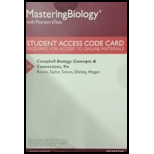
Concept explainers
Suppose you read in the newspaper that a genetic engineering laboratory has developed a procedure for fusing two gametes from the same person (two eggs or two sperm) to form a zygote. The article mentions that an early step in the procedure prevents crossing over from occurring during the formation of the gametes in the donor’s body. The researchers are in the process of determining the genetic makeup of one of their new zygotes. Which of the following predictions do you think they would make? Justify your choice, and explain why you rejected each of the other choices.
a. The zygote would have 46 chromosomes, all of which came from the gamete donor (its one parent), so the zygote would be genetically identical to the gamete donor.
b. The zygote could be genetically identical to the gamete donor, but it is much more likely that it would have an unpredictable mixture of chromosomes from the gamete donor’s parents.
c. The zygote would not be genetically identical to the gamete donor, but it would be genetically identical to one of the donor’s parents.
d. The zygote would not be genetically identical to the gamete donor, but it would be genetically identical to one of the donor’s grandparents.
Want to see the full answer?
Check out a sample textbook solution
Chapter 8 Solutions
Campbell Biology: Concepts & Connections, 9e, Access Code
- You find a person that has a new allele that is not found in DNA samples taken from skin cells of the mother or the father, suggesting that the mutation arose during the formation of the gametes that formed this person. Is it more likely that the mutation was present in the sperm or the egg that formed this person and why do you believe this is the case?”arrow_forwardIn a sample of 1000 patients with Down syndrome, a geneticist discovers that 95% of them are trisomic, while 5% have diploid number of chromosomes. Explain this discrepancy.arrow_forwardAn individual is heterozygous for a reciprocal translocation, with the following chromosomes: A • B C D E F A • B C V W X R ST • U D E F R ST • U V W X Q. Explain why the fertility of this individual is likely to be less than the fertility of an individual without a translocation.arrow_forward
- Assume that a meiotic-nondisjunction event causes trisomy 8 in a newborn. If two of the three copies of chromosome 8 are absolutely identical, at what point during meiosis did the nondisjunction event take place?arrow_forwardA geneticist discovers that a girl with Down syndrome has a Robertsonian translocation involving chromosomes 14 and 21. If she has an older brother who is phenotypically normal, what are the chances that he is a translocation carrier?arrow_forward. With regards to the grasshopper testes experiment, diakinesis is an ideal stage to determine chromosome number due to the degree of condensation of the chromosomes? Count the chromosomes at this stage. Does it represent a diploid or a haploid number?arrow_forward
- Butterflies have an X-Y sex-determination system that is different from that of flies or humans. Female butterflies may be either XY or X0, while butterflies with two or more X chromosomes are males. This photograph shows a tiger swallowtail gynandromorph, which is half male (left side) and half female (right side). Given that the first division of the zygote divides the embryo into the future right and left halves of the butterfly, propose a hypothesis that explains how nondisjunction during the first mitosis might have produced this unusual-looking butterfly. Question is also in the picture.arrow_forwardGenes A and B are on different chromosomes. An individual has the genotype: AaBb You sequence two gametes produced by this individual and find one gamete has the genotype AB, and one has the genotype Ab. How can this one individual (genotype AaBb) produce two gametes with different genotypes (AB or Ab)? Your answer should describe a specific process which occurs during meiosis. At what stage of meiosis does this process occur?arrow_forwardTwo phenotypically normal parents produce a phenotypically abnormal child in which chromosome 5 is missing part of its long arm but has a piece of chromosome 7 attached to it. The child also has one normal copy of chromosome 5 and two normal copies of chromosome 7. With regard to chromosomes 5 and 7, what do you think are the chromosomal compositions of the parents? Would it most likely be reciprocal translocation? It wouldn't be simple translocation because then the child would have the entirety of one chromosome and only some of the other, but in this case, there is only partial chromosome 5 and chromosome 7?arrow_forward
- Certain varieties of chrysanthemums contain 18, 36, 54, 72, and 90 chromosomes; all are multiples of a basic set of nine chromosomes. How would you describe these varieties genetically? What feature do the karyotypes of each variety share? A variety with 27 chromosomes has been discovered, but it is sterile. Why?arrow_forwardConsidering an organism with three pairs of homologous chromosomes, how many different kinds of gametes can this organism produce based on different chromosomal arrangements? Assume that the members of each pair are not identical?arrow_forwardA wild-type chromosome has the following segments: A B C • D E F G H I Researchers have found individuals that are heterozygous for each of the following chromosome mutations. For each mutation, sketch how the wild-type and mutated chromosomes would pair in prophase I of meiosis, showing all chromosome strands. a. A B C • D E F D E F G H I b. A B C • D H I c. A B C • D G F E H I d. A B E D • C F G H Iarrow_forward
 Human Biology (MindTap Course List)BiologyISBN:9781305112100Author:Cecie Starr, Beverly McMillanPublisher:Cengage Learning
Human Biology (MindTap Course List)BiologyISBN:9781305112100Author:Cecie Starr, Beverly McMillanPublisher:Cengage Learning Human Heredity: Principles and Issues (MindTap Co...BiologyISBN:9781305251052Author:Michael CummingsPublisher:Cengage Learning
Human Heredity: Principles and Issues (MindTap Co...BiologyISBN:9781305251052Author:Michael CummingsPublisher:Cengage Learning

